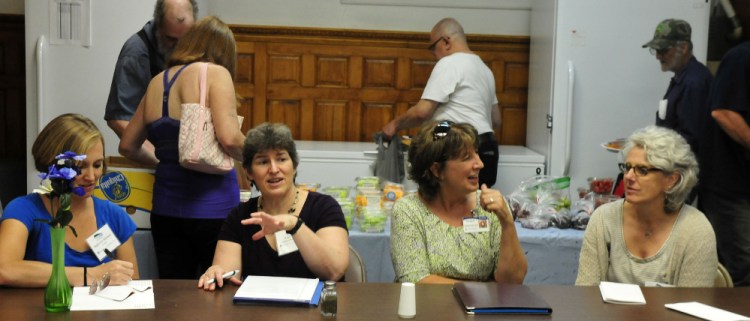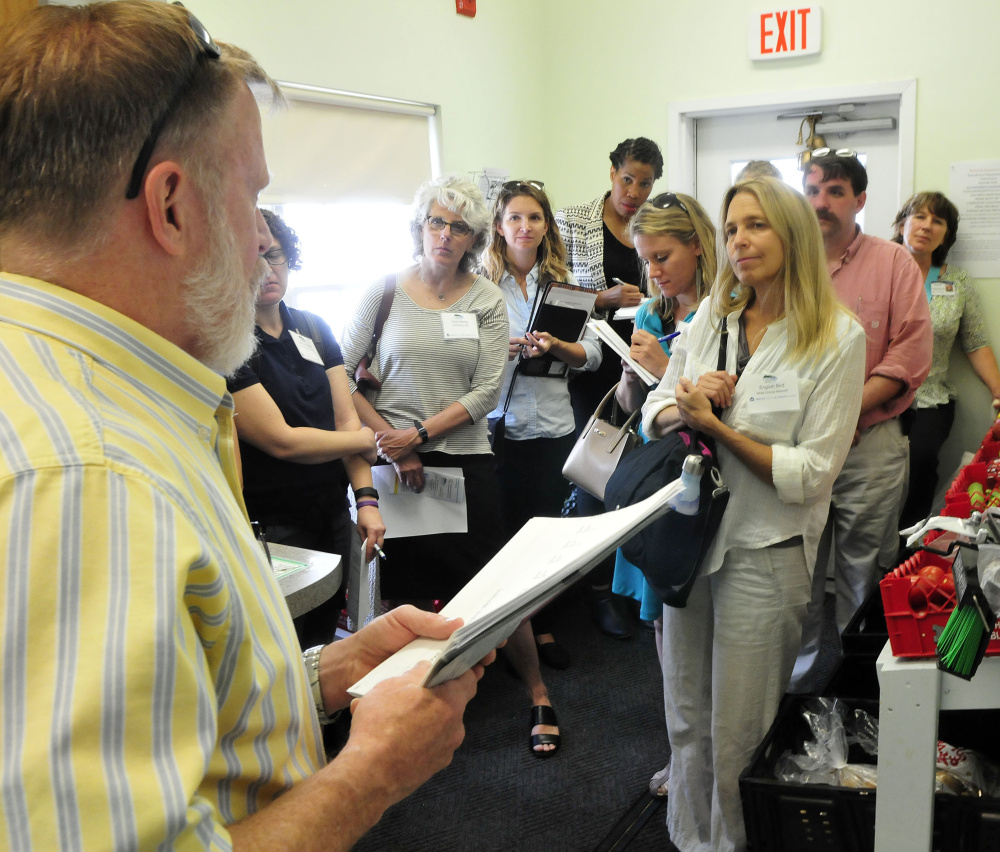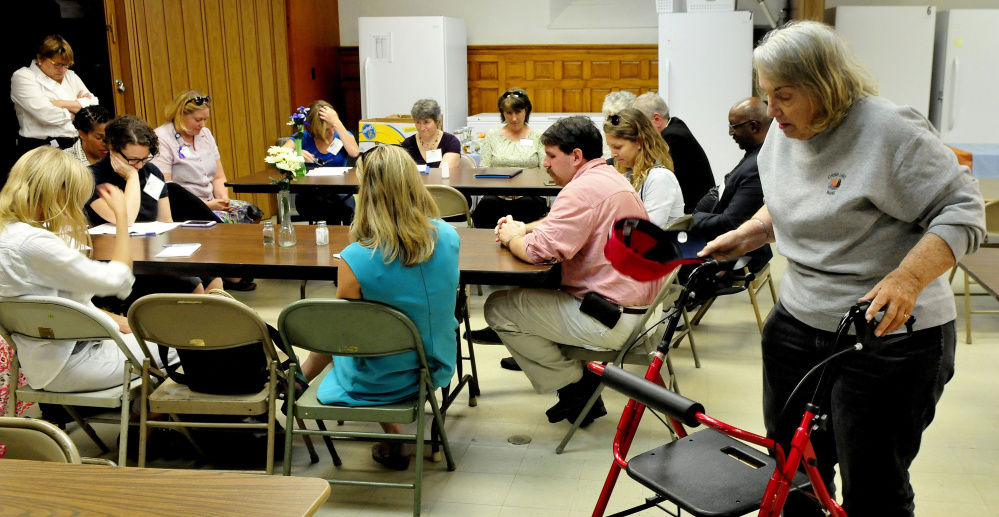WATERVILLE — Many people in the city work together to help ensure children and adults have healthful food to eat, parks and trails for improving physical and mental health, hospitals and other health care facilities to help them stay well, and school, college and city officials who promote wellness.
The city has a farmers market, summer food program for children and community gardens available to the public.
But the poverty rate in Waterville is high. The median household annual income is about $33,000 a year — lower than the state median of $49,000 — with 13 percent of families living in poverty and 25 percent of children living in poverty.
Across the U.S., adolescent obesity quadrupled from 1980 to 2012 and 35 percent of adults are obese.
At the Albert S. Hall elementary school in Waterville, 75 percent of students qualify for free and reduced lunch and 79 percent at the George J. Mitchell School qualify.
Those were statistics Alana Brasier, community planner for Renaissance Planning, based in Orlando, Florida, pointed to Monday night as part of an event called Healthy Places for Healthy People, hosted by Healthy Northern Kennebec and the U.S. Environmental Protection Agency at Senior Spectrum’s Muskie Center.
More than 100 people, including residents, officials from the city, local health organizations, the EPA, U.S. Department of Housing and Urban Development and U.S. Department of Agriculture turned out for the program, which was designed to identify issues, help improve the health of its residents and the environment and increase economic growth. Ben Tucker, regional representative for U.S. Sen. Angus King, also attended.
Healthy Places for Healthy People is a new, 2-day EPA program in which a visiting EPA team helps the community and health care facilities develop strategies and an action plan to address ways to improve health, public safety, basic infrastructure and jobs.
In many communities health care facilities can be catalysts for economic development and investment in neighborhoods can help improve walk-ability, protect air and water quality, conserve open spaces and natural resources and encourage cleanup and reuse of contaminated properties, according to EPA officials.
Waterville is one of only 10 communities nationwide selected this year for the planning assistance program, for which 50 communities applied. Bangor also was chosen.
In Waterville, Healthy Northern Kennebec applied and Waterville was chosen because its commitment to advancing health efforts linked to community livability and economic diversification.
“Waterville is a community that’s just so full of so many great assets,” Stephanie Bertaina, senior policy analyst for the EPA, said just before the event started Monday night. “There are people who really care about their community — institutions like Colby and Thomas colleges, the Alfond Foundation.”
Bertaina, who works in Washington, D.C., said Waterville was selected because there is a lot of good momentum in the city. But the city needs some assistance, she said, and organizers are bringing everyone to the table to help create a vision around creating a healthy Waterville.
Fran Mullin, director of Healthy Northern Kennebec, introduced City Manager Michael Roy who spoke about being of French-Canadian descent. His grandfather, he said, walked from Quebec to the city’s South End in 1902 to settle because Waterville was where the jobs were.
“Waterville’s very, very thrilled to have this opportunity to show what we can do and I think we can do it, for sure, with people like Fran …” Roy said.
COMMUNITY CONNECTIONS
The city’s health and welfare director, Linda Fossa, who also is a member of the Healthy Northern Kennebec board of directors, said that in 2014, groups of people from around the city got together to find ways to ensure people received affordable, healthful food.
“Together, we’re building community connections and listening to one another,” she said.
Ellen Wells, community wellness team leader for Inland Hospital, who also is on the Healthy Northern Kennebec board, said she is excited about the EPA program.
“I believe and have seen over the years how collaboration works to create environmental change,” she said.
Bertaina said that Waterville, having been one of 50 applicants chosen for the program, speaks volumes to the work people in the city already have done. Brasier cited places around the U.S that have increased people’s access to healthful and affordable foods, developed recreational areas including trails and green space, renovated vacant buildings and developed other projects.
She said the people in Waterville are proud of their history and heritage and care about others. That is evident in nonprofit organizations that help those in need, an Opera House lobby that has a box for food donations, a soup kitchen and food bank, and other assets, she said.
Colby College and the Alfond Foundation are investing in downtown revitalization, the Waterville Rotary Club donated funds and is helping to build a river-walk on the Kennebec River and private donors are helping to revitalize the downtown, she said.
“I’ve never been so impressed by a community I’ve been to,” she said.
The biggest issue in Waterville, she said, is food access and food equity because of deep, persistent poverty. Limited transportation opportunities contribute to that, as do reductions in funding streams and perceived limitations of resources and assets. But she said Waterville has done a lot with limited funds and people-power.
Healthy Northern Kennebec is a coalition that seeks to help improve public health by engaging the community in assessing needs and planning ways to succeed. Located at Thayer Center for Health, which is part of MaineGeneral Health, Healthy Northern Kennebec has more than 200 partners. It is working with Colby College, Inland Hospital and others to help revitalize downtown and ensure residents have access to healthful food, health care and economic opportunity.
Earlier Monday, EPA representatives and local health care officials and others toured the city and visited places including City Hall, Waterville Public Library, the Sacred Heart Soup Kitchen, Maine Children’s Home, South End Teen Center, Kennebec Valley Community Action Program and Waterville Food Bank. They also took a “driving tour” of Hathaway Creative Center, Inland Hospital, Thayer, Educare, Albert S. Hall School, Alfond Youth Center and Colby and Thomas colleges.
On Tuesday, the group will meet at the Schair-Swensen-Watson Alumni Center at Colby where city, Colby, Thomas, Maine Access Foundation, Inland, MaineGeneral and social services officials will take part in workshops. They will hear presentations, brainstorm and discuss implementing an action plan.
Amy Calder — 861-9247
Twitter: @AmyCalder17
Send questions/comments to the editors.






Success. Please wait for the page to reload. If the page does not reload within 5 seconds, please refresh the page.
Enter your email and password to access comments.
Hi, to comment on stories you must . This profile is in addition to your subscription and website login.
Already have a commenting profile? .
Invalid username/password.
Please check your email to confirm and complete your registration.
Only subscribers are eligible to post comments. Please subscribe or login first for digital access. Here’s why.
Use the form below to reset your password. When you've submitted your account email, we will send an email with a reset code.